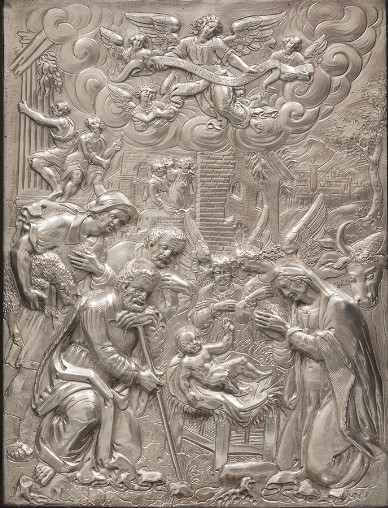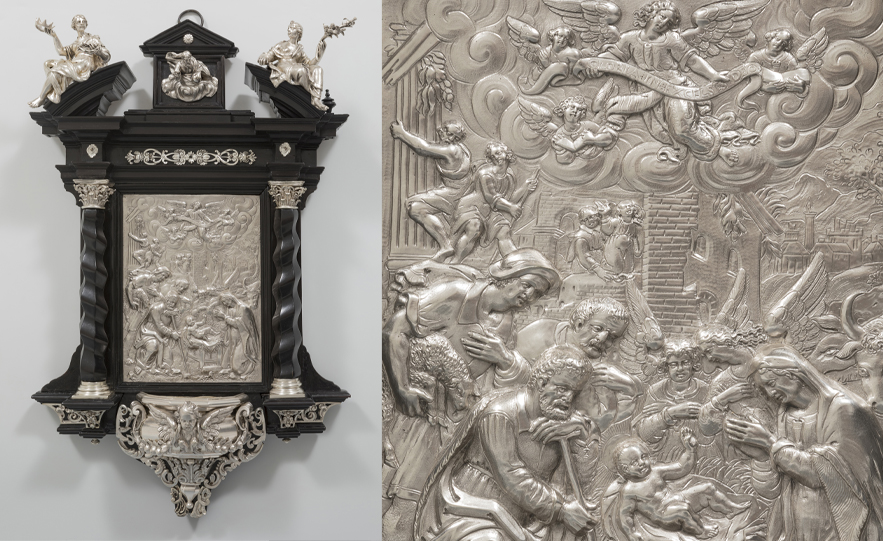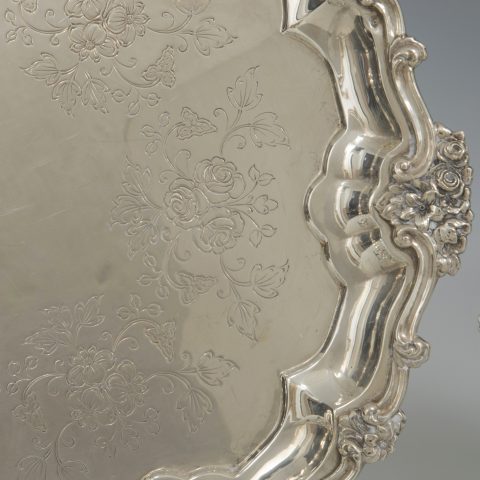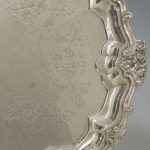Decorative Arts Auction
The lot 35316617, a benditera of contained dimensions made of ebony and silver, stands as one of the most important pieces of the July auction of decorative arts.
The iconography, the formal characteristics and the richness of the materials suggest that it must have been originally created for the private oratory of an important client. The main figures of the central relief have been represented with great care, and have very particular characteristics, such as the sunken cheeks of the male figures, the long-fingered hands, the movement of the clothing and the expressiveness of the faces. The figures in the background and the bust of God the Father, on the other hand, appear more sketched.
The relief scene may have been inspired by a print, while the structure and models, some naturalistic and others idealized, are reminiscent of the work of Guglielmo della Porta (1515 – 1577). The female figures can be found among the drawings made by the sculptor, as well as in some of his works, as well as the angels or the cherub’s head. The general composition also appears in pyxides, reliquaries and other devotional elements created by the sculptor and by the silversmiths who assisted him in his workshop.

Guglielmo della Porta established a workshop in Rome that received artists who, after a period of apprenticeship, could return to their countries of origin, set up on their own or remain with the master until the end of their days. His first apprentice was Jacopo Cobaert, known as “Coppe Fiamingo”. Manno Sbarri and Antonio Gentile da Faenza also passed through the sculptor’s workshop, although in this case as occasional collaborators, as they had their own workshop in Rome from 1550. There were also other artists who learned their craft from della Porta, such as Willem van Tetrode and Giambologna, who were responsible for disseminating his style when they left Rome to settle in other places such as Delft and Florence respectively.
The great success of Guglielmo della Porta’s religious work and the dissemination of his iconography through prints meant that his style spread to a multitude of workshops in southern Germany in the late 16th and 17th centuries.
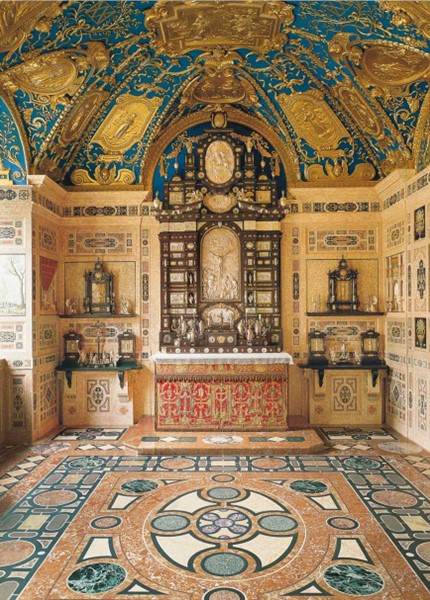

Although the benditera is related to the work of Guglielmo della Porta, as has already been mentioned, it has certain formal elements that suggest that it belongs to the German productions of the city of Augsburg, an important centre for the production of metalwork. The elegant combination of silver and ebony is characteristic of the region, and many examples are known, such as those produced by Matthäus Walbaum (1554-1632). The decorative motifs in silver, such as flowers, leaves or cornice-like mouldings on an ebony structure, are reminiscent of those on pieces such as the altar in the Reiche Kapelle in Munich by Hans Scheibel and Jakob Anthoni.
The same approach can be found in the “Equestrian Portrait of Maximilian III” (c. 1600), in the “Pomeranian Cabinet” (c. 1610), created by Matthäus Walbaum, or the portable altar by Jeremias Flicker (c. 1647), whose relief is a copy of the one represented in the “Calvary” at El Escorial, the work of Antonio Gentile after a model by Guglielmo della Porta.
Moreover, the style used for the benditera relief is very close to the so-called “Master GP”, a silversmith who worked in Augsburg during the last quarter of the 16th century. The “Adoration of the Shepherds”, a silver relief that can be found in the Museum “für Kunst und Gewerbe” in Hamburg, is similar to the one studied, not only with regard to the models of the figures, but also with regard to the construction of the background and, above all, with regard to the group of angels in the upper third who, on a semicircle of clouds, hold a phylactery that reads: GLORIA IN EXCELSIS DEO. PAX HOMINIBVS”. Both pieces share a bold drawing, with confident yet schematic strokes, and the figures are depicted in great detail, revealing the texture of the materials.
